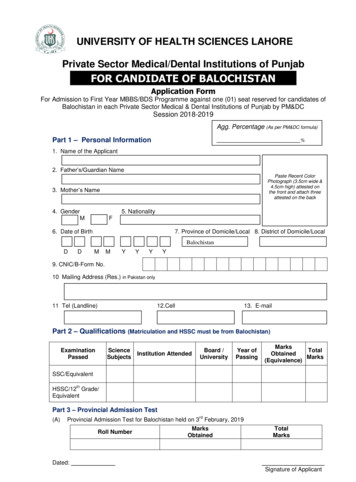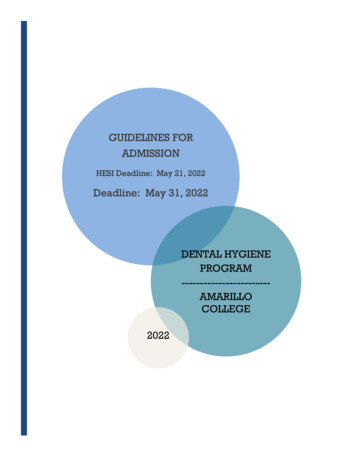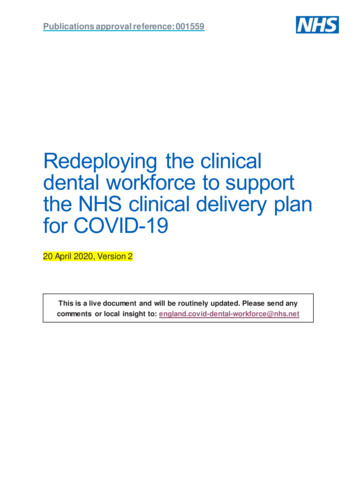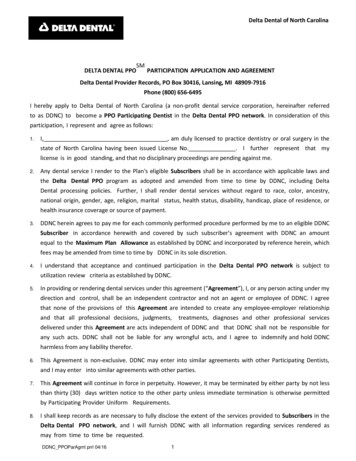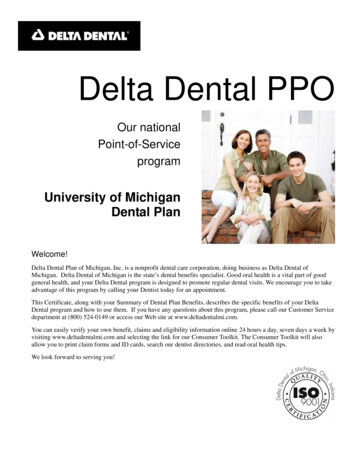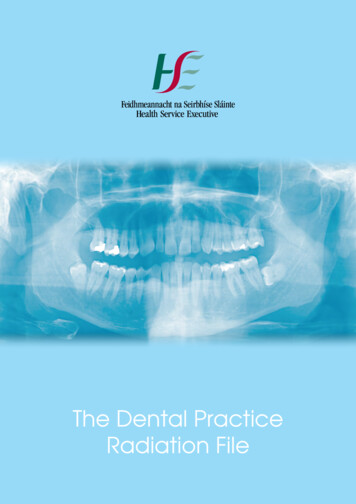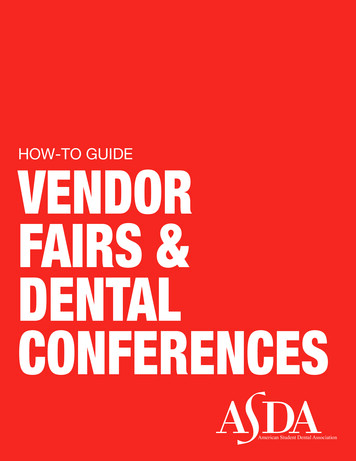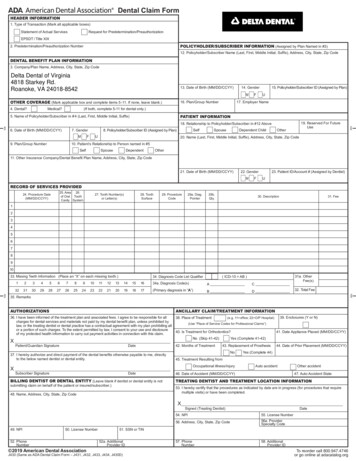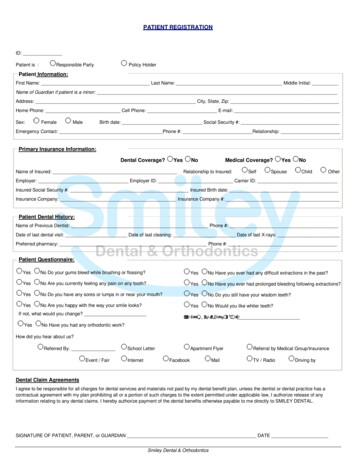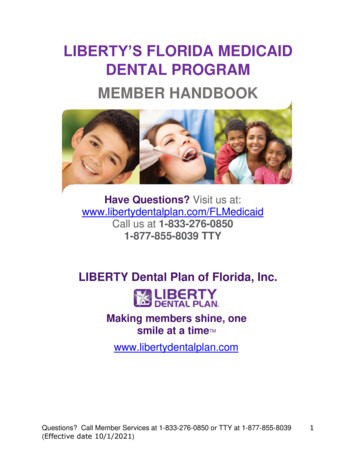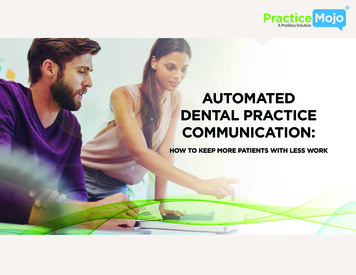
Transcription
AUTOMATEDDENTAL PRACTICECOMMUNICATION:HOW TO KEEP MORE PATIENTS WITH LESS WORK
ContentsTHE IMPORTANCE OF PATIENT RECALLS AND REMINDERS. 3WHY IT’S TIME TO AUTOMATE COMMUNICATION.4COMMUNICATION CHANNELS COMPARISON. 5COMMUNICATION CHANNELS: CALLS & VOICEMAILS. 6COMMUNICATION CHANNELS: SMS TEXTS. 8COMMUNICATION CHANNELS: EMAIL. 9COMMUNICATION CHANNELS: DIRECT MAIL.11COMMUNICATION CHANNELS: SOCIAL MEDIA.13CREATING A PATIENT COMMUNICATION PLAN.16PRACTICEMOJO AUTOMATES PATIENT RECALL AND REVIEWS.18CONCLUSION.192 ProSites PracticeMojo
INTRODUCTIONNothing promotes better dental health than a good relationship betweena patient and their dentist. With a trusted expert on their side, patientscan count on practical advice for preventive care and early diagnosisof bigger issues. Likewise, this same trusting relationship benefits thedental practice. Clear communication means patients are receptive tofollow-ups and future appointments. The patient’s teeth are healthy, andso is the practice. Big smiles all around.Unfortunately, it can be difficult to maintain communication withpatients. Patients are usually busy and often hard to reach. Consistentlyreaching patients at both a good time and in their preferred method ofcommunication – whether phone calls, emails, or even social media – canbe a challenge.Because of the time required to interact with patients, oftentimes eventhe most common communications fail to be sent. It’s hard work to fitunscheduled patients into the practice, which is why automating yourcommunications to get the results you want is critical to the success ofyour practice.Read this guide to learn about the best ways to message your patients,and how to automate each communication channel so you can save timeand money while drastically increasing patient retention and profits.3 ProSites PracticeMojo
THE IMPORTANCE OF PATIENT COMMUNICATIONSWhat if you could keep every patient you ever saw? Production wouldand “difficult to schedule a visit” (23%). Therefore, the best way to build trustskyrocket, gaps in your calendar would fill in, and you could spend less timeis through consistent, timely, and thoughtful patient communications.and money on costly acquisition advertising. Although some churn willalways occur, this idea need not be far-fetched. Besides providing excellentpatient care, the key to better patient relationships is having consistent,personable, and well-timed open communication channels with patients.Different Patients Prefer Different Communication MethodsThe challenge that dental practices encounter when staying in touch withpatients outside their appointments, is that different patients respond betterto one communication channel over another3Keeping Loyal Patients Is More Cost-Effective Than AttractingNew PatientsThe most important forms of communication with current patients are recalls 30% of patients overall prefer appointment reminders via textand reminders. If you increase retention, you’ll improve profitability, as it’s 65% of patients over age 34 prefer reminders by emaileasier and more effective to keep a patient than to attract a new one. In fact, 70% of companies have found that they spend less to retain a customer thanto acquire a new one.1If you increase the budget for retention efforts, such as reminder messages40% prefer to schedule by phone, online, or text rather thanin-person Two-thirds of direct mail is looked at, and more than 40% ofconsumers made a purchase in the past three months becauseof a piece of direct mail they received.4and patient loyalty promotions, you are targeting an audience that hasalready said yes to you once. You have the contact information of existingpatients which means you can reach them without paying for eachThe Bottom Lineinteraction.Consistent, friendly communication with all patients across the differentCommunication Builds TrustAt the end of the day, patients don’t particularly want to switch dentistsunless they have to. In fact, a study found that only 16% of dental patientswere likely to consider switching dentists in the next 12 months.2 Among thetop reasons why a patient would switch providers was “loss of trust” (38%)4 ProSites PracticeMojochannels they prefer will improve your profitability. Varying yourcommunication channels is important, as it limits fatigue and spam filtering,allowing your dental practice to stay top of mind with patients. With stronginteractions, you can remind your loyal but busy patients to come in regularlyand you can reclaim patients who may have become disaffected over time.
WHY IT’S TIME TO AUTOMATE COMMUNICATIONPhone calls, emails, texts, and postcards to existing patients are lessJust the Right Amount of Outreachexpensive than advertising to attract new patients – but it’s a big job. Luckily,A good system is set up to ensure that when a patient gets a call, text, email,there are components that can be automated and still provide a personalor postcard, they don’t receive another instance of the same message in tootouch without involving the whole dental office team.short a time via the same or a different channel. Subsequent touchpointsCheaper and More Effectiveare purposefully varied in their content, timing, and channel to maintainYou can save your front-desk time through patient marketing automationtools. Not only does such a solution prevent over-working your officeinterest and get the desired response. Not to mention, an automated systemcontinues running 24/7, with no sick or vacation days.manager, but it allows staff more time to focus on other vital tasks. Plus,What Automation Says About a Practicewhile there’s always a risk of human error, automated systems increaseWhen dental patients receive a text or automated communication, theyconsistency of communications across all channels. No patient will slipform the opinion that the practice is on the cutting edge with technologythrough the cracks because an automated system follows-up with everyonethroughout. It’s important to also note that 51% of dentists are already usingon its list. Studies demonstrate that patient no-shows decreased 22.95%automated appointment systems now, so it may become an expectationafter dentists set up an automated appointment reminder system.from patients if it isn’t already.54The Bottom LineAutomated patient communications are consistent, always on time, and at abalanced frequency – and they reduce overall costs by saving your front-desktime. Such systems use many different communication channels, and weexplore the major ones in this paper.5 ProSites PracticeMojo
COMMUNICATION CHANNELS: COMPARISONTo start, here is an overview of different communication channels and the types of messages for which they are best suited. Next, we’ll go deeper into each channel.Appointment confirmationsand remindersCalls and VoicemailText MessagingEmailXXXAppointment schedulingXBrand reinforcementXXDaytime reachHIPAA-sensitive info*Social MediaXXXXXInform and announceXXXLong-term reactivationXXNighttime reachXXRappor buildingXSpecial occasionXYear-round awareness*HIPAA is the Health Insurance Portability and Accountability Act6 ProSites PracticeMojoDirect MailXXXXXXX
COMMUNICATION CHANNELS: CALLS AND VOICEMAILFor years phone calls have been the number one way dental offices communicatewith patients. They are one of the safest ways to discuss HIPPA-regulatedinformation.ExampleAuto-reminder calls should use simple scripts that contain allBest Used Forpertinent appointment information and that insert names and timesWhen you need a direct conversation with patients about dental health concerns,automatically. A simple brand mention is appropriate, too. Whetherphone calls are ideal. They are also good for interactive, robotic voicemailsthe patient picks up or lets it go to voicemail, they’ll get the samethat patients can address later, when they have time to confirm upcominginformation.appointments. Some patients might not have a mobile phone or an email address,which makes a landline call one of the most reliable ways to reach them.BenefitsPhone calls provide a warm, personal touch, and they give your practice theHello, Name , this is Dr. Tooth at the Smile Factory! Thisquick call is to remind you that we’ll be seeing you foryour checkup tomorrow, May 20th , at 9:30 a.m. .We’re looking forward to seeing your smile!opportunity to overcome any objections that a patient may have in schedulingtheir next appointment. Calls also allow patients to easily confirm theirappointment by pressing a single button.HIPAA TipsDrawbacksYou and your staff are generally allowed to talk to patients directly on the phonePersonal calls can be time- and labor-intensive—and there’s no telling what aabout PHI (personal health information), such as dental health checkups, homepatient may be doing when you call, which means you could be interrupting them,or you go to voicemail, which could be ignored or forgotten. This is especially truebetween 9 a.m. and 5 p.m—when dental practices typically make calls—becausemost people are working.healthcare instructions, post-appointment follow-up, and treatment plans. Neverleave PHI in a voicemail or on any automated system, instead request a callback.Be sure to understand which activities are classified as “telemarketing,” as youmay first need a patient’s consent before you message them. If the marketing isHow to Automaterelated to the practice’s own offerings, it can still be okay. Read more about HIPAA- Confirm appointments via voicemail.compliant marketing directly from the US Department of Health and Human Schedule automated phone calls for after-work hours between 6 and 8 p.m.Services 6 (please note that this tip does not constitute legal advice).when people are most likely to be available to answer their phones. Use automated calls to reduce the volume of confirmation calls that the officeteam members need to make a day or two before an appointment.7 ProSites PracticeMojo
COMMUNICATION CHANNELS: TEXT MESSAGINGNinety percent of US adults have mobile phones,7 and 50.8% use only mobilewith no landline at all, a trend that is growing at roughly 5% per year. When8How to Automate Set interactive auto-confirmation texts to trigger five to seven days before anappointment (e.g. “Reply YES to confirm, or call to reschedule.”). Schedule noninteractive reminder texts for the day before or day of, with afriendly message and an address if needed. Do not give an automated option to cancel an appointment.combined with the general dislike of phone calls by young people, it meansthat texts must be part of your communication mix.Best Used ForText messages are best for auto-confirmations and for day-before and sameday appointment reminders.BenefitsExamples A text is typically unobtrusive and short by nature. A text doesn’t take upAuto-confirmations should be enthusiastic but straight to the pointroom in a cluttered email inbox, or ring someone’s phone during a meeting—Thanks for making an appointment at 3 p.m. on Thursday, May 1, with Dr. Kimihira! Please confirm by replying YES or call to reschedule.and it can be read and understood in seconds. Plus, with simple replycommands, a patient can confirm an appointment with something as simple as “Y” and then move on with their day.Some services also include two-way text messaging, meaning your officemanager can jump in on an automated message thread to reply to patientsand give them a truly personal conversation. Whether used to fill last-minuteopenings, remind patients to bring forms, or alert them about a personal item Auto-reminders are a good place to show personality and put people at ease, reducing no-shows You’re just a day away from a brighter, whiter smile! See you at 3 p.m. tomorrow – Dr. Kimihiraleft behind at the office, two-way texting is convenient and reflects well on your practice.DrawbacksHIPAA TipsEach text costs money to send. Additionally, not every phone numberMany of the same regulations that apply to phone calls apply to texts. Whenthat a patient provides is a mobile phone, which could result in a failedcommunication attempt.8 ProSites PracticeMojoselecting an “automated” texting service, it is wise to choose one that enablestwo-way texting, capturing all incoming and outgoing data into a patient’s chartto allow for fully HIPPA-complaint audit trails.
COMMUNICATION CHANNELS: EMAILThanks to smartphones, many customers have constant access to email evenif they don’t have a desk job. Emails are the first thing 22% of people checkon their phones in the morning9, and 33.8% check their emails more than 10times throughout the day10. Emails will be seen, and if done right, they will beread too.Best Used ForEmails are versatile and should be used for various reasons. Theseinclude practice marketing, appointment reminders and confirmations,birthday greetings, newsletters, and longer or less time-sensitive personalcommunications. They are also great for post-visit messages that request anpeople may not read them right away. Plus, it’s not uncommon for patientsonline review of your practice.to have multiple email addresses (e.g., personal email and work email). AndBenefitsEmails have space for more content, allowing your practice to display itsto reduce spam and volume of emails, they may selectively share an emailaddress that they don’t check often.personality and branding through a logo, team photo, collages of smilingHow to Automatepatients, and even videos. Most importantly, emails can contain links to your Choose a platform that automatically populates contact informationwebsite’s appointment request form or schedule apps and in some cases, can(e.g., “ FirstName , thanks so much for ”) to decrease time spentautomatically place appointments in patients’ calendars, such as Outlook orcustomizing email campaigns.Google Calendar, which helps prevent no-shows. DrawbacksEmails typically have lower open rates, simply because people receive far toomany of them. On average, people receive 121 emails a day, meaning yourCreate a variety of email series that trigger timed sends forappointment reminders, say, a week and then a day out. Schedule holiday and seasonal emails for all patients, like back-toschool for families, winter season’s greetings, Halloween “scary toothwell-intentioned practice marketing and appointment reminders can easilyprevention” tips, and the like.be lost in the mix. Unlike a call or text, emails tend not to be “urgent,” so Ensure that there’s only one message per family (sometimes called“family messaging”).9 ProSites PracticeMojo
Examples1Visit recap emails are the perfect way to remind patients howgrateful you are for their business and to request patient reviews.Thank you so much for seeing us for a cleaning at ValkyrieDental. We hope you enjoyed your visit.Would you be willing to share your feedback so that otherpatients can see what it’s like to work with our practice? Ifyou have a second, please leave us a review on Yelp.We look forward to seeing you soon!-Dr. Valkyrie2Treatment plan follow-ups are a natural continuing-caremessage, and through email they can include enoughinformation and links to increase the chances of case acceptance.We are excited to announce a brand-new, in-officewhitening procedure now available at our practice! Clickthe video below to learn more. dental teeth whitening video Interested in getting brighter, whiter teeth today?Click the link below to set your appointment: calendar with selectable dates/times Have a good rest of your day!- Dr. ValkyrieHIPAA TipsYou must ensure that your email service provider (the one that sends automated email series for you) uses HIPAA-compliant encryption to protect PHI. It is wise touse a disclaimer on the bottom of email messages to prevent liability on the part of the practice. For example:“The information contained in this transmission may contain privileged and confidential information, including patient information protected by federal and stateprivacy laws. It is intended only for the use of the person(s) named above. If you are not the intended recipient, you are hereby notified that any review, dissemination,distribution, or duplication of this communication is strictly prohibited. If you are not the intended recipient, please contact the sender by reply email and destroy allcopies of the original message.”10 ProSites PracticeMojo
COMMUNICATION CHANNELS: DIRECT MAILIn an age of dwindling physical mail, receiving a personalized card stands out.Patients are more likely to look it over—and hang onto it longer too.Best Used ForPostcards are best used for patient retention and as part of the recall andreminder mix. They are also good for practice announcements, such as a newpractice location or associate, or to advise patients of important changes toinsurance or financial terms. You can send long-time-no-see reminders toget back on patients’ minds, as well as holiday cards to stay with them yearround. Especially powerful are birthday cards because, marketing message ornot, it’s nice when someone remembers your special day.BenefitsIn the age of daily email spam, postcards catch attention and can reactivatea dormant patient. Dentists using postcards have seen as much as a 750%return on investment (ROI), in part because this form of communicationis so relatively inexpensive and because it is somewhat unexpected. Thephysicality of a glossy, friendly postcard is so novel at this point that itper card, an entire year of campaigns does add up. You must have a patient’scurrent home address for postcards to hit the mark, of course. Also, it’sdifficult to track engagement with a postcard—you don’t have digital metricson open or click-through rates. You can always ask patients if they saw it, butresponses will be subject to recall biases.How to Automate or a new location) and special promotional offers.becomes an asset in and of itself. A postcard also has a lot of staying power—recipients can’t just click delete –and people can leave it on the counter or hang it on the fridge as a reminder.DrawbacksThe obvious downside is cost – postcards must be designed, printed, andmailed. Some services charge 1 of a standard postcard. While not expensive11 ProSites PracticeMojoTarget all patients with practice announcements (such as insurance changesMake it the primary communication channel for patients who don’t have anemail address or mobile phone number on file.a patient receiving Send postcards to patients who haven’t responded to a six-month remindertexts or emails.
ExamplesBenefit reminder cards get forgetful patients back in at no cost tothem, making it a win-win.Holiday cards get keep your practice in mind when it matters the most.HIPAA TipsSo long as postcards are only for patient recall or season’s greetings, you should be fine under HIPAA. Obviously, don’t send any treatment specifics or PHI printed onthe postcard, as there would be no chance of privacy.12 ProSites PracticeMojo
COMMUNICATION CHANNELS: SOCIAL MEDIATen years ago only 5% of the U population was on social media. Fast-forwardDrawbacksto today, and it’s now used by 69% of U.S. adults!12 A strong social mediaManaging your practice’s social media accounts is time-consuming. Itpresence has become vital to a practice’s success and presents uniquerequires dedication to posting high-quality, relevant and engaging contentopportunities for patient interaction and engagement.while also managing and responding to reviews, questions, and comments.Best Used ForTo do well in Facebook community management, whoever is handling it mustSocial media is best for responding to reviews (both positive and negative)to demonstrate an attentive practice and for responding to any directmessages, questions, or comments that users might have. Facebook is alsoa good place to collect various types of information to better understandbe well versed in the basics of technology and marketing. The platform neversleeps and requires frequent attention. It is a full-time job, and if it’s simplyadded to a staff member’s responsibilities, things could be missed.How to Automatepatients. You can conduct small surveys or polls to learn opinions and utilize“social listening” to see what people are saying about topics related to Chatbots are automated artificial intelligence that handle instant messagingand provide resources to patients in a real time and in a more naturaldentistry.way. They are becoming more popular and can be used to automate theBenefitsmessenger part of Facebook.Social media is effective because of its immediacy, how often people connectwith it, and the wealth of patient data it contains. Having a solid social Other forms of automation aren’t possible in direct Facebookpresence, especially on Facebook, makes your practice appear modern.communications, but there are inexpensive ways to outsource the work soBeing responsive to questions and concerns is like a sign of life for frequentthat it becomes less of a chore and doesn’t require additional staff.social media users. And when you manage customer service issues well ina public forum, you signal to other patients that you are a caring dentistwho doesn’t ignore problems. Best of all, reviews on your practice’s pagecontribute to a star rating tied to a map location, and each review appearswith a real person’s name and face. Because of these aspects, in additionto a sense of community, what social media brings most of all is trust andtransparency.13 ProSites PracticeMojo
ExamplesResponding to Facebook criticism in a calm, polite manner is vital togood community management. Get the commenter to a different form ofcommunication as fast as possible.Dr. Book: Excited to see so many prom-ready smiles! picture of dental patients smiling Ashley Promgoer: DR. BOOK COULDN’T GET MY TEETHWHITE AND MY PROM PICTURES LOOK HORRIBLE!!!!Dr. Book: We appreciate your feedback and are sorry tohear that you were not satisfied with your service. Wewill reach out to you directly via phone to make sure youare satisfied.Chatbots can be used in Facebook messaging to free up staff time fromanswering basic questions, and they can pass information over to an employeewhen a live person is needed.Curious Patient: What are your hours?RoboDental DDS: We are open Monday throughFriday, from 9 a.m. to 3p.m. Do you want to make anappointment?Curious Patient: No not yet. Where are you located?RoboDental DDS: You can find our practice at 123 FakeStreet. <map>Curious Patient: Okay, thanks. Maybe I’ll make anappointment later.RoboDental DDS: Our pleasure! If you’d like to make anappointment, you can use our easy scheduling tool atany time www.robodental.com/schedule-appointment.HIPAA TipsFor social media interactions, it is more a matter of training staff on HIPAA-compliant communications than anything else. It’s a good idea to have a practice widesocial media policy that includes information about what to look out for, such as avoiding posting even the tiniest identifying details regarding patients—time of day,date, and location of an appointment, for example. Don’t post anything, even vaguely, about a patient without their consent—photos, case studies, anything. Thisgoes for interactions in Facebook Messenger, too. It is reasonable to assume a lack of privacy in all social media interactions, so play it safe. See the Society for Human Resource Management sample on which to base your own policy.1314 ProSites PracticeMojo
CREATING A PATIENT COMMUNICATION PLANWith all the foregoing channels at your disposal, you can craft a completecommunication plan that reaches your patients regardless of gaps in thecontact information you have for them. It will require a tool that can pulldata from your practice management software and stay in sync with it—youdon’t want to risk double-messaging someone and putting them off withyour outreach efforts.A good communication plan involves not only an automation tool but alsoknowledgeable, friendly people behind it to give oversight and correctpotential errors. For example, an office manager may know that yourpatient Felecia has an email on file but that she never responds to email, sothe assistant excises email from Felicia’s communication plan.15 ProSites PracticeMojo
Example Communication PlanThe following is an ideal way to move a patient from the acquisition funnel to the retention cycle so that you can be sure to maximize their lifetime value.Appointment FunnelThe receptionist captures an emailAn appointment confirmation is sent viaThe patient remembers theand phone number from an initial formtext, and the patient texts back “YES,” asappointment, shows up, and has a greatcompletion on the practice’s website.The receptionist emails the prospectivepatient a link to the site’s scheduling page,and the new patient requests an appointment.16 ProSites PracticeMojoprompted, to confirm.first experience with the practice.A one-day reminder text is sent.
Retention Phase: The Continuous CycleThe patient is in the practicePatient receives an emailPatient receives an eNewsletterPatient receives newslettersmanagement systemthanking them andfrom their dentist with tips andjust often enough where theyand receives automatedrequesting a review.office updates.aren’t annoyed and don’tunsubscribe.communications.One day afterappointment.One month afterappointment.Office manager sees the patient’sPatient receives a text,name on a list of of people toemail and postcard from thefollow-up with. Receptionist callspractice encouraging anotherthe patient and invites them to aappointment.cleaning. Patient accepts.At the appointedcontinuing care date.One week later17 ProSites PracticeMojoEvery few weeksPatient goes throughreminder steps again, withmore follow-ups in thefuture.Ongoing
Annual Marketing Touchpoints to Build LoyaltySelecting the Right Tool for the PlanYou can reach out to patients throughout the year for many other reasonsWhen considering an automated patient communications provider, here arethan appointment reminders.some questions to ask: Benefit reminders. If a patient has dental insurance but has not made anappointment, sending reminders to “use it or lose it” is a perfect way to getthem back in. It’s truly win-win because the patient generally pays little or posts?nothing, and your practice can get hygiene and potential treatment casesWhat if a patient doesn’t have one of the communication methods in mytoo.communication plan?Holidays. Postcards sent with well wishes and cute surprises for everyWhat if patients remain unscheduled for a very long time?occasion are a nice way to keep your practice top of mind. Halloween, withCan I change the timing and method of all of my communications?its ubiquitous candy, is a great opportunity to talk about teeth, as is EasterDoes this tool consider families who might be receiving duplicate com-and Valentine’s Day. For the winter holiday season, it is recommended tomunications?stay non-denominational and suggest they get their smiles perfect forDoes this sync with my practice management software?“holiday cards.” Can it schedule phone calls, texts, emails, postcards, and social mediaBirthdays. Sending an email or card wishing a “happy birthday” andDo you have visual content and scripts for me, or do I have to provideeverything on my own?including a small promotional offer can be great—just be sure not to makeWhat is the price? Are there contracts involved?the reward too big, or patients might learn to wait around for their nextWhat isn’t included in the price (e.g., phone calls, postcards, online ap-birthday before making future appointments.pointment scheduling)?Cust
allowing your dental practice to stay top of mind with patients. With strong interactions, you can remind your loyal but busy patients to come in regularly and you can reclaim patients who may have become disaffected over time. 30% of patients overall prefer appointment reminders via . text 65% of patients over age 34 prefer reminders .


